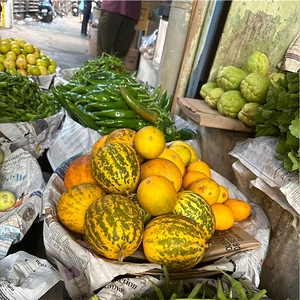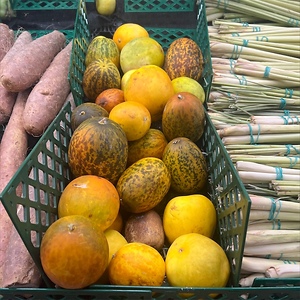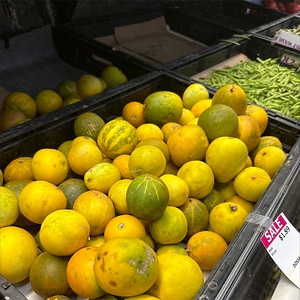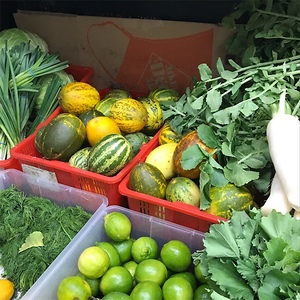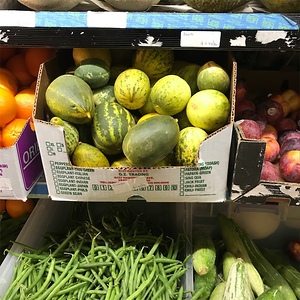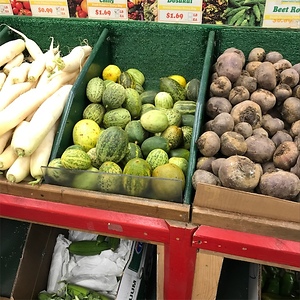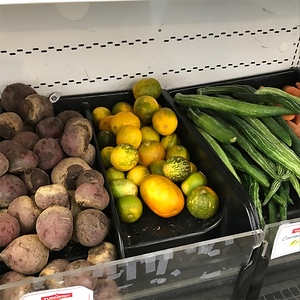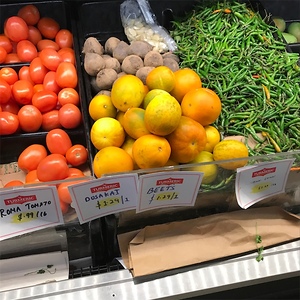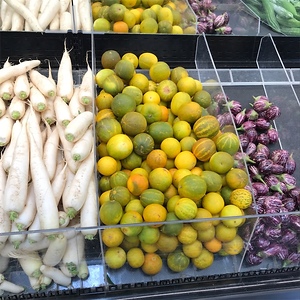


Dosakai
Estimated Inventory, lb : 0
Description/Taste
Dosakai cucumbers are small rounded fruits that vary in size from as small as a lime to as large as a grapefruit. They can have a circular or oblong shape that may be slightly narrower near the stem and fuller at the bottom. This variety features a mostly smooth yet slightly bumpy thin rind that ranges in color from yellow to dark green or a mottled blend of both. The rind is often adorned with intermittent stripes and spots. As these cucumbers mature, their skin becomes darker yellow and the green patches grow smaller. These fruits have a cream-white translucent flesh that’s firm, aqueous, and slightly crunchy, akin to a raw zucchini. Within this flesh is a relatively large seed cavity containing small peach-colored seeds in the center. Dosakai cucumbers have an aroma similar to Asian pears and sweet apples with floral undertones. These fruits have a semi-sweet flavor that’s tangy and sweet.
Seasons/Availability
Dosakai cucumbers are available year-round with a peak season during the summer.
Current Facts
Dosakai cucumbers are botanically classified as Cucumis melo var. Chito and belong to the Cucurbitaceae family along with melons, squash, and gourds. These fruits are native to India and are known by various names in different Indian languages including Vellari in Malayalam, Dosekaya in Telugu, Kankri or Khira in Hindi, and Sambar Vellari in Malayalam. They are technically classified as both a fruit and a melon but are often referred to as cucumbers and treated as a vegetable in culinary use. This variety is particularly popular in the South Indian state of Andhra Pradesh and in Sri Lanka. Dosakai cucumber plants flourish on sprawling vines with heart-shaped leaves that are often grown on trellises and hanging baskets in gardens. This plant is primarily valued for its culinary applications, producing cucumbers that are commonly used for slicing and pickling.
Nutritional Value
Dosakai cucumbers are a rich source of dietary fiber that aids in digestive health by promoting regularity and helping eliminate toxins from the gut to support a clean and balanced digestive system. The presence of vitamin C in these fruits boosts immunity, supports skin health, and acts as a powerful antioxidant, while their vitamin E content further enhances skin health and combats oxidative stress. Vitamin K in Dosakai cucumbers plays a crucial role in blood clotting and bone health. This variety also possesses potassium and magnesium to help regulate blood pressure, maintain heart health, and support muscle and nerve function.
Applications
Dosakai cucumbers can be consumed raw, stir-fried, sautéed, or boiled. They’re often sliced and eaten as a snack or combined with greens and fresh vegetables in salads. This variety is frequently incorporated into koottu and sambar curry, lentil vegetable soups popular in India. Dosakai cucumbers are also used in a meat and vegetable curry called korma that is braised in yogurt and spices to create a gravy-like texture. This variety can be sliced and added to tea sandwiches, pitas, and raita salads made with onions, tomatoes, and lime then mixed with a yogurt, cumin, and fresh herb dressing. These fruits are incorporated into chutneys and relish with ingredients like coconut, chilies, curry leaves, mustard seeds, and garlic. Dosakai cucumbers pair well with turmeric, cumin, ginger, sesame seeds, coriander, spinach, green beans, okra, eggplant, eggs, chicken, potatoes, and mango. They will keep for about two weeks when stored in the crisper drawer of the refrigerator.
Ethnic/Cultural Info
Dosakai cucumbers are very popular in Andhra Pradesh, an Indian state known for its rich consumption of highly spicy food. These fruits are used in dosavakaya, a pickled appetizer made with mustard seeds, red chili powder, sesame oil, and salt. Dosavakaya is appreciated for its tart yet spicy flavor that’s often served with steamed rice. It may also be eaten with ghee and pappu annam, a lentil-based dal soup that’s made with spinach, tomatoes, and Dosakai cucumbers. The pickling process for making dosavakaya is quicker than that of traditional mango pickles and is popular in Telugu households across Southern India.
Geography/History
Dosakai cucumbers are native to India where they have been cultivated for thousands of years. These fruits are grown in warm, tropical, and subtropical climates with full sun exposure, fertile soils, and ideal temperatures between 21 and 35 degrees Celcius. This cultivated variety is not found in the wild but is frequently produced commercially and in home gardens. Dosakai cucumbers are a descendent of the cucumber species that likely originated in the Indian regions between the Bay of Bengal and the Himalayas. Cucumbers were then introduced to China in the 2nd century BCE and started being cultivated in North Africa, Italy, Greece, and Asia Minor by the 1st century CE. Like most Indian cucumber varieties, Dosakai has spread to various regions and is now popular throughout Southern Asia. Dosakai cucumbers can also be found in Indian and Asian markets worldwide and are available for purchase as seeds for home gardening.
Recipe Ideas
Recipes that include Dosakai. One



